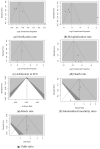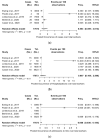Vaccinating Welders against Pneumococcus: Evidence from a Systematic Review and Meta-Analysis
- PMID: 37766171
- PMCID: PMC10535919
- DOI: 10.3390/vaccines11091495
Vaccinating Welders against Pneumococcus: Evidence from a Systematic Review and Meta-Analysis
Abstract
Workers occupationally exposed to welding dusts and fumes have been suspected to be at increased risk of invasive pneumococcal disease (IPD). Since the 2010s, the United Kingdom Department of Health and the German Ständige Impfkommission (STIKO) actively recommend welders undergo immunization with the 23-valent polysaccharide (PPV23) pneumococcal vaccine, but this recommendation has not been extensively shared by international health authorities. The present meta-analysis was therefore designed to collect available evidence on the occurrence of pneumococcal infection and IPD among welders and workers exposed to welding fumes, in order to ascertain the effective base of evidence for this recommendation. PubMed, Embase and MedRxiv databases were searched without a timeframe restriction for the occurrence of pneumococcal infections and IPD among welders and workers exposed to metal dusts, and articles meeting the inclusion criteria were included in a random-effect meta-analysis model. From 854 entries, 14 articles (1.6%) underwent quantitative analysis, including eight retrospective studies (publication range: 1980-2010), and six reports of professional clusters in shipbuilding (range: 2017-2020). Welders had an increased likelihood of developing IPD compared with non-welders (odds ratio 2.59, 95% CI 2.00-3.35, I2 = 0%, p = 0.58), and an increased likelihood of dying from IPD (standardized mortality ratio (SMR) 2.42, 95% CI 1.96-2.99, I2 = 0%, p = 0.58). Serotype typing was available for 72 cases, 60.3% of which were represented by serotype 4, followed by 12F (19.2%) and serotype 8 (8.2%). Although the available data derive from a limited number of studies, available results suggest that pneumococcal vaccination should be recommended for workers exposed to welding fumes, and vaccination strategies should consider the delivery of recombinant formulates in order to combine the direct protection against serotypes of occupational interest with the mucosal immunization, reducing the circulation of the pathogen in occupational settings characterized by close interpersonal contact.
Keywords: Streptococcus pneumoniae; invasive pneumococcal disease; occupational disease; pneumococcus; prevalence.
Conflict of interest statement
The authors declare no conflicts of interest.
Figures











Similar articles
-
Vaccinating welders against pneumonia.Occup Med (Lond). 2012 Jul;62(5):325-30. doi: 10.1093/occmed/kqs055. Occup Med (Lond). 2012. PMID: 22764269 Free PMC article. Review.
-
Occupational exposure to dust and to fumes, work as a welder and invasive pneumococcal disease risk.Occup Environ Med. 2020 Feb;77(2):57-63. doi: 10.1136/oemed-2019-106175. Epub 2019 Dec 17. Occup Environ Med. 2020. PMID: 31848233 Free PMC article.
-
Serious pneumococcal disease outbreak in men exposed to metal fume - detection, response and future prevention through pneumococcal vaccination.Vaccine. 2017 Jul 13;35(32):3945-3950. doi: 10.1016/j.vaccine.2017.06.010. Epub 2017 Jun 19. Vaccine. 2017. PMID: 28633889
-
Direct effectiveness of pneumococcal polysaccharide vaccine against invasive pneumococcal disease and non-bacteremic pneumococcal pneumonia in elderly population in the era of pneumococcal conjugate vaccine: A case-control study.Vaccine. 2019 May 9;37(21):2797-2804. doi: 10.1016/j.vaccine.2019.04.017. Epub 2019 Apr 17. Vaccine. 2019. PMID: 31005428
-
Vaccine effectiveness of the pneumococcal polysaccharide and conjugated vaccines in elderly and high-risk populations in preventing invasive pneumococcal disease: a systematic search and meta-analysis.Eur Clin Respir J. 2023 Jan 20;10(1):2168354. doi: 10.1080/20018525.2023.2168354. eCollection 2023. Eur Clin Respir J. 2023. PMID: 36698750 Free PMC article. Review.
Cited by
-
Occupationally Relevant Zinc- and Copper-Containing Metal Fumes Inhibit Human THP-1 Macrophage TNF and IL-6 Responses to Bacterial Stimuli.Glob Chall. 2024 Dec 31;9(5):2400302. doi: 10.1002/gch2.202400302. eCollection 2025 May. Glob Chall. 2024. PMID: 40352634 Free PMC article.
-
Cost-Effectiveness of the Pneumococcal Vaccine in the Adult Population: A Systematic Review.Healthcare (Basel). 2024 Dec 9;12(23):2490. doi: 10.3390/healthcare12232490. Healthcare (Basel). 2024. PMID: 39685112 Free PMC article. Review.
-
Seroprevalence of Crimean Congo Hemorrhagic Fever Virus in Occupational Settings: Systematic Review and Meta-Analysis.Trop Med Infect Dis. 2023 Sep 19;8(9):452. doi: 10.3390/tropicalmed8090452. Trop Med Infect Dis. 2023. PMID: 37755913 Free PMC article. Review.
-
Second reported outbreak of pneumococcal pneumonia among shipyard employees in Turku, Finland, August-October 2023: a case-control study.Epidemiol Infect. 2025 Feb 3;153:e32. doi: 10.1017/S0950268824001870. Epidemiol Infect. 2025. PMID: 39895563 Free PMC article.
References
-
- Tsang R.S.W. A Narrative Review of the Molecular Epidemiology and Laboratory Surveillance of Vaccine Preventable Bacterial Meningitis Agents: Streptococcus Pneumoniae, Neisseria meningitidis, Haemophilus influenzae and Streptococcus agalactiae. Microorganisms. 2021;9:449. doi: 10.3390/microorganisms9020449. - DOI - PMC - PubMed
Publication types
LinkOut - more resources
Full Text Sources

